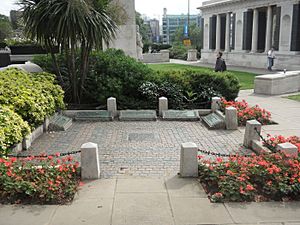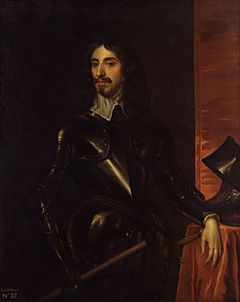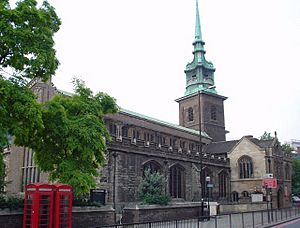Eusebius Andrews (Royalist) facts for kids
Quick facts for kids
Colonel
Eusebius Andrews
|
|
|---|---|

Site of the scaffold at Tower Hill where Andrews was executed
|
|
| Personal details | |
| Born | Baptised 20 December 1606 St Dunstan's, Stepney, England |
| Died | 22 August 1650 (aged 43) Tower Hill |
| Resting place | All Hallows-by-the-Tower |
| Political party | Royalist |
| Spouses | Unknown, died before 1650 |
| Children | Katherine (1637); Matilda (1640-after 1685) |
| Alma mater | Christ's College, Cambridge |
| Occupation | Royalist conspirator |
| Profession | Lawyer |
| Military service | |
| Years of service | 1642 to 1646 |
| Rank | Colonel |
| Battles/wars | Wars of the Three Kingdoms Worcester |
Eusebius Andrews (born December 1606, died 22 August 1650) was a lawyer from London. He was a strong supporter of the King, known as a Royalist, during the Wars of the Three Kingdoms. He was executed because he was part of a secret plan in 1650. This plan aimed to bring Charles II of England back to the throne.
Andrews had supported the King since the early 1630s. He was very determined and helped organize several Royalist uprisings in Cambridgeshire between 1642 and 1650. In 1650, one of the people involved in his plot was actually a secret agent for the government. Andrews was arrested in March while trying to escape to the Dutch Republic. He was beheaded at Tower Hill on 22 August 1650. After the King returned to power in 1660, Andrews was remembered as a hero who died for the Royalist cause.
Contents
Who Was Eusebius Andrews?
Eusebius Andrews was born in Edmonton, London. He was baptized on 20 December 1606. He was the only child of Eusebius Andrew and his first wife, Joan Dudley. He also had a half-sister named Katherine from his father's second marriage.
Andrews got married sometime before 1637. We don't know his wife's name. She likely died before 1650, as she is not mentioned in his will. They had two daughters: Katherine, who was born and died in 1637, and Matilda, born around 1640. Matilda lived until after 1685.
Andrews' Life as a Lawyer and Royalist
Andrews studied at Christ's College, Cambridge. He then became a lawyer, just like his father. He joined Lincoln's Inn, a famous legal society, in 1620. By 1627, he became a qualified lawyer, known as a barrister.
He was a strong supporter of Charles I of England and Archbishop William Laud. In 1635, he helped to prosecute Robert Mason. Mason was a high-ranking lawyer in London and an opponent of King Charles I's rule. This was a brave move because Mason was also a leader at Lincoln's Inn. Andrews was removed from his position there for going against their old customs. He then moved to Cambridgeshire, near the Isle of Ely, and continued his law practice.

The English Civil War
Andrews was in London when big political changes began in November 1640. In May 1641, he accused John Lilburne, a religious radical, of speaking against the King. When the First English Civil War started in August 1642, Andrews was back in Cambridgeshire. He worked with the Bishop of Ely to issue royal announcements.
Cambridgeshire was mostly on the side of Parliament, known as Parliamentarians. In 1643, Andrews joined the Royalists in Oxford. His rank of colonel was likely an honorary title. He probably didn't lead a regiment in battle. He might have been involved in a secret plan to take over Ely in 1644.
Andrews stated that he was the personal secretary to Lord Capel. Capel was related to Andrews' step-mother. Andrews and Capel were with the Prince of Wales in 1645. However, they did not go into exile with him in March 1646. Andrews was listed among the officers who surrendered at Worcester just before the war ended in July. He then returned to Ely.
During the Second English Civil War in 1648, Andrews and Capel tried to capture Linton, Cambridgeshire. When they failed, Andrews escaped to The Hague. Capel was captured and later executed in March 1649.
The 1650 Plot and Arrest
After King Charles I was executed in January 1649, the Scots declared Charles II their king. They began talks to bring him back to the English throne. Charles II also supported other plans to regain power.
Andrews was living in Suffolk in September 1649. A former military major named John Barnard asked him to support another uprising in the Isle of Ely. Barnard and another witness against Andrews, named Pitt, were actually government secret agents.
By December 1649, the Royalists in Ireland were almost defeated. In early 1650, Parliament ordered the arrest of people like Andrews who refused to support the new government. Andrews planned to move to North America. But Barnard convinced him to stay, hoping to catch more people in the plot.
One person involved was Sir John Gell, 1st Baronet. He was a former Parliamentarian commander. Andrews realized the plot was going nowhere. He prepared to leave for Holland but was arrested at Gravesend, Kent on 24 March 1650.
Trial and Execution
On 30 March, Andrews was sent to the Tower of London. He was accused of treason, which means betraying his country. When questioned, he pointed out that Barnard had encouraged the plot. The chief judge, Bradshaw, admitted this. However, he said Andrews' own statements showed his plans to overthrow the government.
Andrews' trial was delayed until 16 August. This was done in hopes that he would give information about other people involved.

At his trial, Andrews argued that the court did not have the right to judge him. He said it went against important laws like Magna Carta. Judge Bradshaw had rejected these same arguments when Charles I used them in his own trial. So, the verdict was clear. Andrews was found guilty and sentenced to death on 19 August. Parliament changed his punishment to beheading instead of the usual, more severe penalty.
Eusebius Andrews was executed on 22 August 1650. He was buried in All Hallows-by-the-Tower church. This church was often used for people who died at Tower Hill. Andrews had asked to be buried near Archbishop Laud, who was executed in 1645. After the King returned to power in 1660, Andrews was honored in books as a Royalist martyr.
Images for kids


